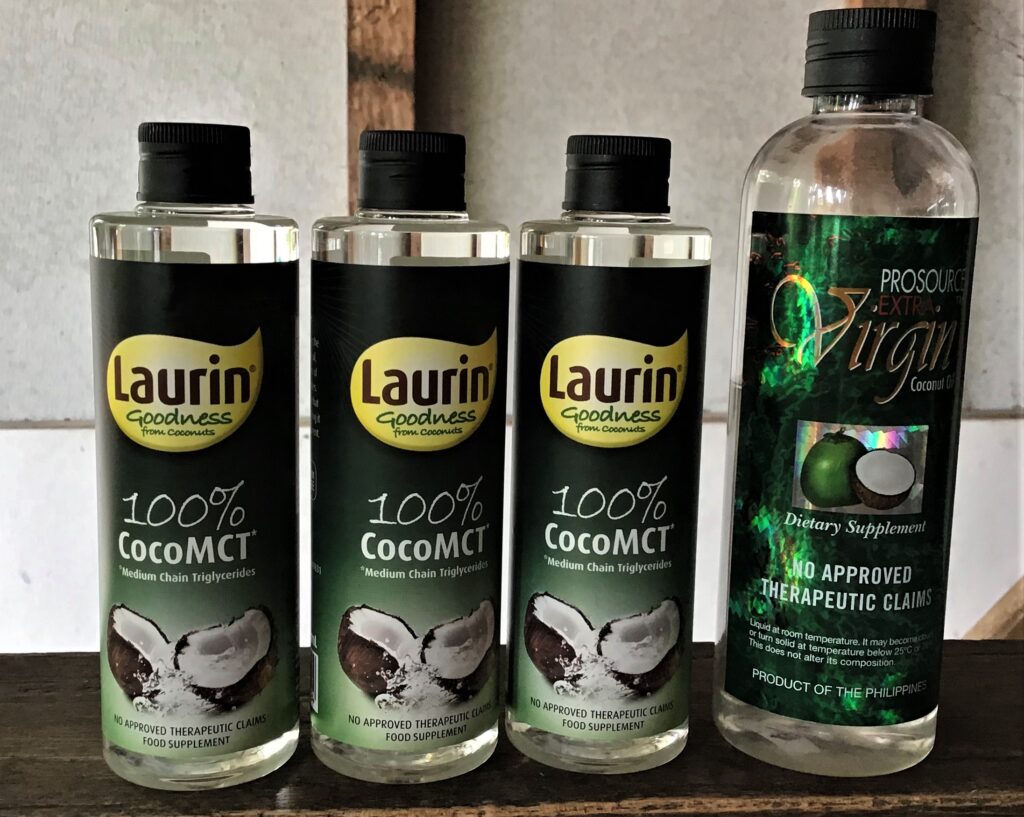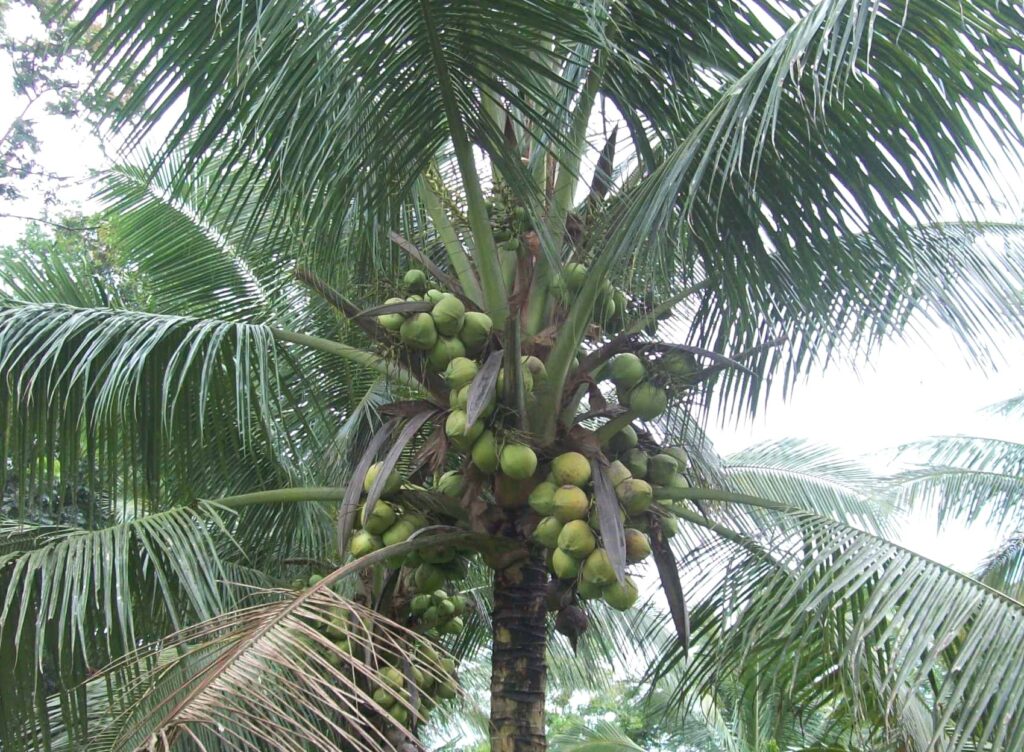Text and Photos by Henrylito D. Tacio
Officially, it has been confirmed.
Virgin coconut oil (VCO) – which is rich in lauric acid, a powerful biochemical that helps boost the immune system – could diminish symptoms of coronavirus disease 2019 (COVID-19).
The joint study headed by the Food and Nutrition Research Institute (FNRI) of the Department of Science and Technology (DOST) has shown that VCO could be used as a supplement to probable and suspect cases of COVID-19.
As an adjunct supplement, “VCO could prevent probable and suspect COVID-19 cases from becoming severe,” said Science Secretary Fortunato dela Pena during the presentation of the findings of the study that was disclosed to the media in a virtual conference.
The study team evaluated the effects of VCO on suspects, and probable cases of COVID-19 quarantined at the Santa Rosa Community Quarantine Facility and at the Santa Rosa Community Hospital, both in Santa Rosa City, Laguna.

Investigators randomly assigned the volunteers into either the Intervention or VCO Group or the Control Group. The intervention lasted for 28 days and involved 57 suspect and probable COVID-19 patients. There were 29 cases who were in the VCO Group and 28 in the Control Group.
Among the criteria used for the exclusion of patients in the study were: considered suspect or probable COVID-19 case, 20 years and older, has been admitted in the quarantine facility three days or less at the time of baseline data collection, willing to participate, with controlled hypertension and maintenance drugs and with normal liver enzyme tests.
Excluded from the study were those patients with a history of heart ailment, taking statins or medications for heart disease, has a history of hyperlipidemia or high cholesterol levels, asymptomatic, and pregnant.
Participants in the Intervention or VCO Group were given standardized meals mixed with VCO developed by DOST-FNRI. The Control Group also received the usual standardized meals but without VCO.
Meals were cooked by a contracted catering service in the area, while the precise amount of VCO was mixed on-site by registered nutritionist-dietitians hired specifically for the study.
Meals were served free of charge and delivered in the quarantine facilities during the participants’ confinement and later at their respective homes after being already discharged.
An initial dose of 0.6 milliliters of VCO per kilogram of body weight was mixed with the standard breakfast meals of the VCO Group on the first three days of the trial. The dose was increased to 1.2 milliliters of VCO per kilogram of body weight mixed with the standard breakfast and lunch of the VCO Group from Day 4 to 28.
Study participants in the VCO Group with reported VCO intolerance were given computed amounts of VCO per kilogram of body weight in their standard breakfast, lunch, and dinner meals.
COVID-19 symptoms like cough, colds, body aches, headache, loss of taste and smell, and fever were monitored daily during the whole course of the study.

Here are some of the findings of the study:
· Immediate effects of the VCO intervention were observed among five of the 29 patients in the VCO Group who experienced decreasing signs and symptoms of COVID-19 as early as Day 2, while only one patient from the Control Group showed similar improvement.
· The VCO Group experienced no more symptoms on Day 18, while the Control Group exhibited no symptoms only on Day 23.
· The diminishing signs and symptoms of COVID-19 in the VCO Group were supported by the decreasing levels of C-Reactive Protein (CRP) of the participants. A CRP – a quantitative marker used in monitoring inflammation or infections – equal or less than 5 milligrams per liter signifies recovery from inflammation or infection.
· Mean CRP levels of the VCO Group normalized to 5 milligrams per liter or less as early as Day 14 and continuously decreased until Day 18,
· Normalization of CRP levels in the Control Group was also evident from Day 1 to Day 14, but this remained at the borderline of 5 milligrams per liter from Day 14 until the end of the intervention.
With these findings, “VCO could be used as an adjunct supplement to probable and suspect COVID-19 cases,” said Dela Pena. Although he admitted that more studies are still needed “to determine the effectiveness of VCO as adjunct therapy for COVID-19 patients and with other co-morbidities.”
Among the people involved in the study were Imelda Angeles-Agdeppa, Mario V. Capanzana, Jacus S. Nacis, Carl Vincent D. Cabanilla, Fabian Antonio M. Dayrit, and Jaime Montoya.
Aside from FNRI and the City of Santa Rosa’s local government unit, other government agencies involved with the study were the Philippine Council for Health Research and Development, the DOST of CALABARZON, and the Ateneo de Manila University.
To ensure product quality and compliance to Philippine National Standards, the VCO used in the study was strictly analyzed by the Laboratory Services Division of the Philippine Coconut Authority (PCA).
VCO – the purest form of coconut oil, essentially water-clear or colorless – can be prepared at home. It can be produced with or without the use of heat, without undergoing chemical refining, bleaching, or deodorizing, which does not alter the nature of the soil.
According to PCA, there are two ways of preparing VCO: fresh-dry or fresh-wet. It is considered fresh-dry when VCO is obtained directly from fresh coconut meat. Drying of fresh comminuted kernels (ground, grated or milled) is required before extracting the VCO.
Fresh-wet is used when VCO is obtained from fresh coconut milk. Coconut milk is extracted either mechanically or manually, with or without the addition of water.
The late National Scientist Dr. Conrado S. Dayrit was touted to be the Father of VCO. His book, The Truth About Coconut Oil, published in 2005, became a bestseller and elevated coconut oil from folk medicine to a scientific therapy. He was a cardiologist and professor of pharmacology at the University of the Philippines College of Medicine.
“Today, people are returning to natural diets in order to live healthier and happier lives – the hallmarks of ‘wellness’ – and science has been validating the benefits,” Dayrit wrote in the prologue of Coconut Oil: From Diet to Therapy, which he co-authored with his son, Fabian.
“One of the natural foods being rediscovered is coconut. Although vilified as a cause of heart disease, coconut oil has always shown itself to be a healthy and curative oil. Numerous studies using the tools of modern science are finally revealing – and validating – the beneficial effects of coconut oil.”
Several studies show VCO is rich in lauric acid, a medium-chain fatty acid (MCFA) converted to monolaurin by the human body. “Fifty percent of coconut oil is lauric acid, a compound found in human breast milk, which makes it one of the best food sources for this nutrient available,” Ty Bollinger, a best-selling author, medical researcher, and health freedom advocate.
The Philippines is the second-largest coconut producing country in the world, after Indonesia. Of the 12 million hectares of total agricultural land, 3.5 million hectares are dedicated to coconut production, the Philippine Statistics Authority (PSA) reports.
The Philippines introduced VCO to the world in 2000-2001 and remains the world’s number one VCO exporter. In 2015, VCO was exported to 46 countries, the United Coconut Association of the Philippines said. The top importers were the United States, the Netherlands, Canada, Germany, and Japan. Other destinations were Belgium, the United Kingdom, South Korea, and Australia. Smaller volumes went to Malaysia, Brazil, Taiwan, South Africa, France, China, Singapore, and Czechoslovakia.

